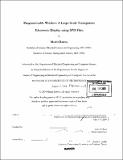Programmable window : a large-scale transparent electronic display using SPD film
Author(s)
Ramos, Martin (Ramos Rizo-Patron)
DownloadFull printable version (9.270Mb)
Other Contributors
Massachusetts Institute of Technology. Dept. of Electrical Engineering and Computer Science.
Advisor
Carlos F. Ratti.
Terms of use
Metadata
Show full item recordAbstract
This research demonstrates that Suspended Particle Device (SPD) film is a viable option for the development of large-scale transparent display systems. The thesis analyzes the SPD film from an architectural display application standpoint, observing its steady-state and dynamic electro-optical response and evaluating different strategies to address, drive and control the independent transparency levels of an SPD pixel array. Although passive matrix multiplexing can also be implemented, it is determined that a directly addressed, multi-line strobing technique is best suited given the constraints of AC drive, power consumption and load bi-directional conductivity of the currently available film. With regards to transparency control, a high-voltage pulse width modulation strategy proves optimal in terms of functionality and component overhead. A prototype display system that incorporates these findings is built, illustrating the key electrical considerations, design features and versatility that ought to be part of future implementations of the system. (cont.) "A huge electronic display on a skyscraper facade can be interesting to passing pedestrians, but if you're inside the building it simply blocks your view. Researchers at MIT's Media Laboratory and Department of Urban Studies and Planning are developing a transparent display that doesn't entirely block incoming light. The group is adapting a commercial available film used in electronic window shades, a high-tech alternative to blinds or curtains that lightens and darkens when electricity is applied and removed. The display will be a matrix of small separate pieces of the film. A grid of tiny wire. will connect the pieces to a computer, which will be able to compose letters and figures in grayscale patters. Because the film at its darkest blocks only 40percent of incoming light, and because only some of the pieces in the matrix. will be darkened at any given time, people sitting behind the display will still be able to see out. "-- Technology Review Magazine, November 2003.
Description
Thesis (M. Eng.)--Massachusetts Institute of Technology, Dept. of Electrical Engineering and Computer Science, 2004. Includes bibliographical references (leaves 86-87).
Date issued
2004Department
Massachusetts Institute of Technology. Department of Electrical Engineering and Computer SciencePublisher
Massachusetts Institute of Technology
Keywords
Electrical Engineering and Computer Science.